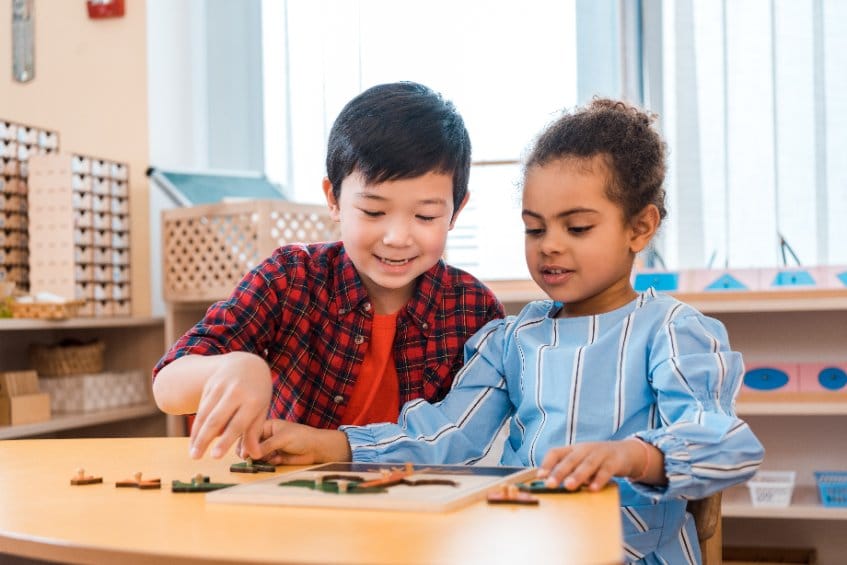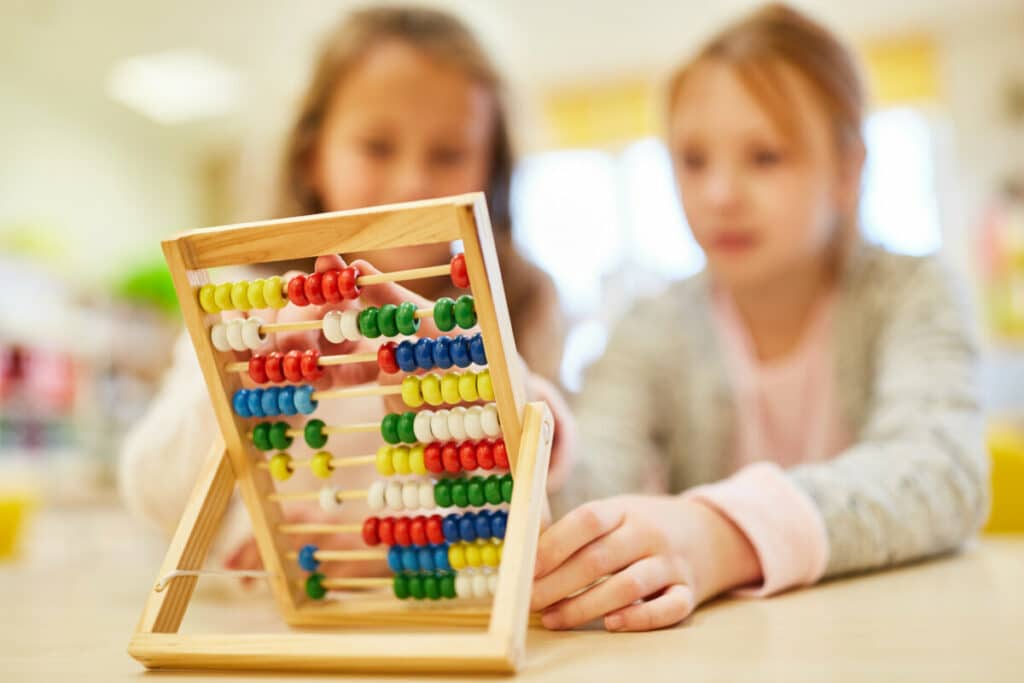What Exactly is a Montessori School? A Parent’s Guide
Have you heard of a Montessori school? Do you often hear it in conversation but don’t exactly know what it is and what it all entails? Are you a parent wanting to be more informed about Montessori and how it works? This article can help you learn more about how a Montessori school works!
What Happens in a Montessori School?
When you enter a classroom in a Montessori school, you will notice how it visually looks a little different in the sense that the students are not sitting at individual desks with their attention at the front of the classroom while the teacher is lecturing. The students can be found sitting at tables with their peers engaged in an activity that the teacher explained and demonstrated at the beginning of the class.
The students will have the time after being instructed to use the materials and tools placed at their respective tables to then participate in an activity that corresponds with the lesson that day, giving them hands-on experience. While the students aren’t being directed by the teacher for their every move, they are expected to work through it themselves and use their peers and teacher as a resource if and when they have questions that come up.
This helps foster an environment of independent learning, allowing each student to have their own experience and education on each topic.
Individual Experiences
The vision of Montessori education is to allow each student to individually gain their education through their own experience while being surrounded by their peers who are doing the same. Most classrooms have 25 students in total but the teacher makes an effort to teach the student individually instead of the class as a whole.
After being given the same instruction from the teacher, each student will independently then participate in an activity on their own to practice and apply the concept they have just gone over on their own.
This may sound very similar to some public classrooms you have attended. The difference in a Montessori classroom is that only students who present interest and desire and progression in the subject and activity presented have to participate. If they are not interested or have not mastered the previous skills needed to move on, they will continue working independently to be ready to move on rather than moving on with their other peers who may be advancing.
Multiple Ages in Each Classroom
Depending on when the child’s birthday is, there may be a 1-2 year difference between all the students in a traditional classroom. In a Montessori classroom, there can be age differences of up to 3 years between students. Instead of grouping students by age, they are grouped by levels of interest in specific subjects as well as social skills. This is not intended to “hold” students back, but rather to place or keep them in a learning environment that is most beneficial to them at that time so they can have the best chance to learn all they can in an independent manner.
This wider age range of students can also present opportunities for children to have exposure to interacting with peers of various ages, rather than those who are of the same or close age. This can help instill an understanding of mentorship for the older students to take the younger students under their wing and for the younger students to accept and respect those in positions of leadership.
Sense of Independence
Most children begin to have that desire to be more independent around the time they start kindergarten. They start wanting to take charge of their actions and make their own choices. Montessori caters to that desire to be independent in giving them several pieces of work and letting them decide when to work on the assignment but also giving them a due date to simultaneously grant them a sense of independence while still keeping them accountable.
Children are offered more options and opportunities to make decisions for themselves. Some more examples include the choice of where they would like to sit to work on their assignments, whether that be on the floor or at the table, or the choice of whether to work on their science assignment or math assignment.
Although the students are granted more freedom in Montessori, there are still rules set in place that don’t allow the students to distract each other from their work which helps keep them disciplined
Learning Through Action
Contrary to traditional classrooms, students don’t sit in individual desks lined up facing the front of the classroom in an effort to direct all their focus and attention on the teacher during an hour-long lecture. For some students, this has been found to be more ineffective in keeping a productive attitude among the students in the class.
In a Montessori school, there are several prepared tables with various hands-on activities for the children to choose from and work independently on. The children take part in experiments and activities rather than worksheets and tests.
The children are free to move around the classroom to find a space that is comfortable for them to participate in their chosen activity or experiment, with the caveat that they don’t distract any of the other students from their work. The idea of having the children take action in the lessons rather than just listen to the lessons, helps them feel like they are personally contributing and progressing in their education instead of being required to sit still and listen all day.

Controlled & Prepared Environment
While the space in the classroom where students sit is different, each classroom is still stocked with all the necessary supplies and tools that the students may need while in class. The organization and cleaning of those supplies and tools are completely put into the children’s hands as their responsibility with the supervision of the teacher.
The supplies are kept at a level that is accessible to all students to be able to grab whatever they need when they need it during their hands-on learning. Just as they have the freedom to go and use the supplies, they are also responsible for both cleaning the supplies they used, putting them away, and keeping the area they take the supplies from organized.
This helps give the children a sense of independence as well as teaching them about taking responsibility, showing respect for, and sharing things, even things that don’t belong to them.
Uninterrupted Learning
While it often is the case that young children have a short attention span and struggle to focus through a 30-minute math lesson, Montessori schools give each “learning period” a length of 2-3 hours on one subject or project the student may be working on before changing their focus to something else.
This is a helpful indicator if the student is interested and prepared for the subject and if they can handle and be productive for a longer period of time without becoming distracted or disinterested.
This longer period of focus on one subject allows the students to get further and deeper into the material than they would if they had been limited to 30-minute sessions. It allows them to get deep enough to start asking questions and building on the surface-level information that they would only start to get to in a shorter amount of time lesson. It really is a more efficient way to learn the material in a shorter period of time.
Real-Life Learning
In addition to academic learning, Montessori schools also include lessons that deal with everyday life in their classrooms. The types of lessons vary from age group and capability. Some of the lessons for younger children can include learning how to tie their shoes, how to pour a drink without spilling, and basic manners like “please” and “thank you”. Some of the lessons for the older children can include how to handle money, as well as the basics of how to start a small business.
While some parents may be appreciative of the school taking on some of these life lessons, some parents prefer to keep those in the home, and Montessori schools are not required to teach these real-life lessons, but they are offered as an added courtesy in addition to their other academics during schooling hours. If you would prefer to not have these lessons taught to your children at school, just mention it to the teacher and they should be accommodating.
Teachers Become Facilitators
Montessori schools have teachers but refer to them as “facilitators” because rather than teaching, their real purpose is to facilitate and let the children take the reigns in their learning. Their purpose is to introduce each activity that the children have to choose from at the beginning of the class, let the children choose their option and then assist them on a one-on-one basis if/when they have questions.
Facilitators really take a backseat and let the children dive into their work and are there in case they need help, but they aren’t ignorant if there are needs of the children that need to be attended to. They are actively participating in the student’s learning but aren’t directing it in any specific way which allows the student to take charge of their education, hopefully then helping them understand the value of it as well.
Well-Rounded Education
While participating in Montessori education, children receive 3 types of education simultaneously: academic, practical (real-life), and emotional. Emotional education is often forgotten and pushed to the side in public schools, leaving it to the school counselor or parents to attend to. Montessori schools believe that an educational environment is an appropriate place to teach several types of education, including emotional education.
It is important to understand that emotional education is taught in very basic ways. Yoga, meditation, and deep breathing, among other practices, all help the children become aware of their emotions, where they come from, and how to control them.
This could be going on in the same classroom as another student is doing a science experiment. Various forms of education are present in a Montessori classroom and that is what helps create a well-rounded education for the student to participate in.
Why Parents Should be Involved
A big ideal that Montessori education provides and fosters in the classroom is that learning can be done anywhere with anything. Learning doesn’t have to just be limited to a classroom. They want to send the children home with a desire to continue learning throughout their lives. This is where the importance of parental involvement comes in. It is important that you as the parent, talk to your child about education in a positive manner.
If the child has a positive experience at school but then comes home and receives a negative reaction from their parents about what they learned at school or about their homework, that can confuse the child and cause feels of shame and avoidance of becoming completely involved in their education, which is the whole goal of Montessori education. But by encouraging and praising them with positive affirmations, you can continue to fuel that desire for learning in them.
How Parents Can Be Involved
In addition to having a positive attitude towards your child’s education, there are some more ways to become involved in your child’s learning. One way is to maintain order. At school they are in charge of getting, returning, and cleaning their materials. They should continue this at home to instill a more solid habit and help them understand that those responsibilities are not limited to the classroom.
This could include requirements to have a clean room every night before bed or helping clean up dinner before going and playing with friends.
Another way is to give your children more opportunities to practice responsibility. This could be done by doing chores around the house and then earning a few dollars, with the opportunity to teach them about finances.
If you have a pet, you could give them the opportunity to walk the dog every day and teach them about the importance of caring for a pet. Things like this will help them feel more independent and capable of things, rather than being reliant on their parents.

